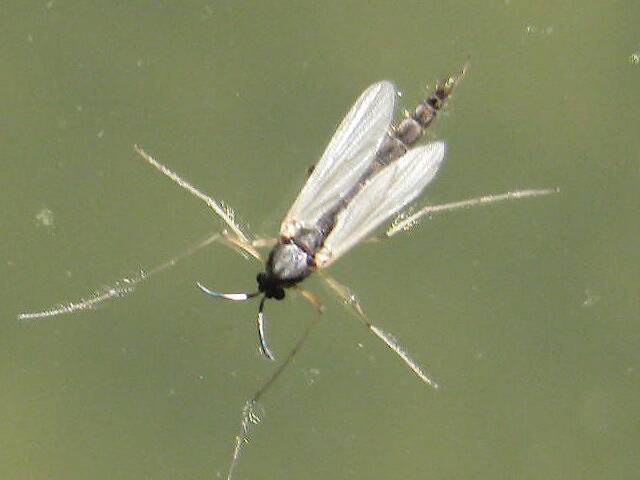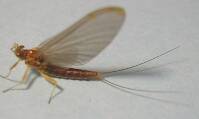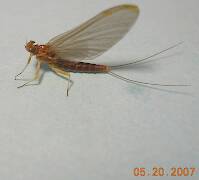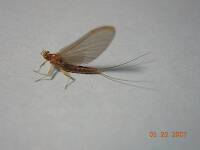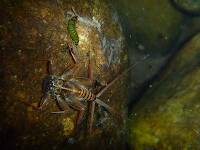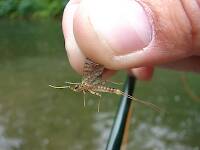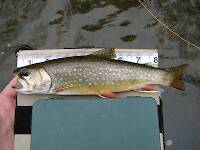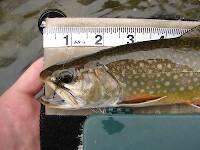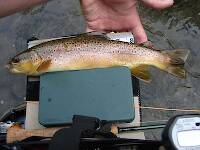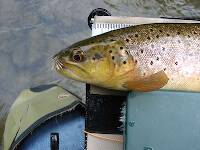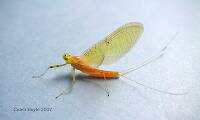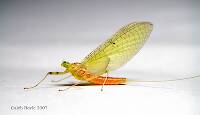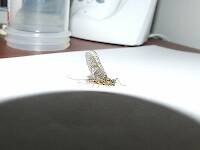
Salmonflies
Pteronarcys californica
The giant Salmonflies of the Western mountains are legendary for their proclivity to elicit consistent dry-fly action and ferocious strikes.
Featured on the forum

I was not fishing, but happened to be at an unrelated social event on a hill above this tiny creek (which I never even saw) when this stonefly flew by me. I assume it came from there. Some key characteristics are tricky to follow, but process of elimination ultimately led me to Sweltsa borealis. It is reassuringly similar to this specimen posted by Bob Newell years ago. It is also so strikingly similar to this nymph from the same river system that I'm comfortable identifying that nymph from this adult. I was especially pleased with the closeup photo of four mites parasitizing this one.

Troutnut is a project started in 2003 by salmonid ecologist Jason "Troutnut" Neuswanger to help anglers and
fly tyers unabashedly embrace the entomological side of the sport. Learn more about Troutnut or
support the project for an enhanced experience here.
Oldredbarn on Jun 11, 2010June 11th, 2010, 4:28 pm EDT
John,
Now that's cool! Look at those eyes.
Have we officially now tagged our insecto-zoids the "bug-boys"? If the "integument" fits, eh?! If we didn't love them or consider them our own, we would just leave them alone.
Great pics, man!
Spence
Now that's cool! Look at those eyes.
Have we officially now tagged our insecto-zoids the "bug-boys"? If the "integument" fits, eh?! If we didn't love them or consider them our own, we would just leave them alone.
Great pics, man!
Spence
"Even when my best efforts fail it's a satisfying challenge, and that, after all, is the essence of fly fishing." -Chauncy Lively
"Envy not the man who lives beside the river, but the man the river flows through." Joseph T Heywood
"Envy not the man who lives beside the river, but the man the river flows through." Joseph T Heywood
Oldredbarn on Jun 11, 2010June 11th, 2010, 5:22 pm EDT
Can I guess? I think this is one of those bugs that has had a Mac-attack...Was educated at Purdue and spent its spring breaks somewhere in Mexico...I could be wrong...Not sure how it found its way to Wisconsin...though. Some where along the line it almost lost all its integrity. I could be wrong...Better head to the frig for another Molson...Having a problem post Stanley Cup playoffs and no Red Wings to be seen anywhere...
Tony...How ya doing now that our "beloved" Hossa has a Cup?
Spence
Tony...How ya doing now that our "beloved" Hossa has a Cup?
Spence
"Even when my best efforts fail it's a satisfying challenge, and that, after all, is the essence of fly fishing." -Chauncy Lively
"Envy not the man who lives beside the river, but the man the river flows through." Joseph T Heywood
"Envy not the man who lives beside the river, but the man the river flows through." Joseph T Heywood
Taxon on Jun 11, 2010June 11th, 2010, 6:28 pm EDT
John,
Not Stenacron, most likely Maccaffertium, which I assume Spence was alluding to by Mac-attack and Purdue. As to species, I'll leave that to Lloyd to suggest, as identifying a Maccaffertium female subimago to species is way beyond my pay grade. Yes, Spence, I got your reference to Mexico, but don't want to comment concerning species, let alone subspecies.
Not Stenacron, most likely Maccaffertium, which I assume Spence was alluding to by Mac-attack and Purdue. As to species, I'll leave that to Lloyd to suggest, as identifying a Maccaffertium female subimago to species is way beyond my pay grade. Yes, Spence, I got your reference to Mexico, but don't want to comment concerning species, let alone subspecies.
Wiflyfisher on Jun 12, 2010June 12th, 2010, 1:34 am EDT
Roger, this use to be so much simpler when they were all under Stenonema. Years ago I would have probably called it Stenonema rubrum.
I guess than that this is probably Maccaffertium modestum female subimago, which Jason has photos of from probably the same river as mine came from.
If I had known Spence would be chiming in, I would have put the mayfly on a hockey puck and taken the photos.
I guess than that this is probably Maccaffertium modestum female subimago, which Jason has photos of from probably the same river as mine came from.
If I had known Spence would be chiming in, I would have put the mayfly on a hockey puck and taken the photos.
John S.
https://WiFlyFisher.com
https://WiFlyFisher.com
Oldredbarn on Jun 12, 2010June 12th, 2010, 8:48 am EDT
Roger,
I was just over working the silly side of my brain here...Sorry! Wifes in upstate NY and I'm without ice hockey, I have been on a diet since Jan and just swallowed too many Molson's...It was more than a stretch.
I guess, "while the cat's away the mouse" finds his way to the beer store. I almost pulled the post before I headed up to bed but was too tired. The wifes "honey-do" list is a mile long!
Spence
I was just over working the silly side of my brain here...Sorry! Wifes in upstate NY and I'm without ice hockey, I have been on a diet since Jan and just swallowed too many Molson's...It was more than a stretch.
I guess, "while the cat's away the mouse" finds his way to the beer store. I almost pulled the post before I headed up to bed but was too tired. The wifes "honey-do" list is a mile long!
Spence
"Even when my best efforts fail it's a satisfying challenge, and that, after all, is the essence of fly fishing." -Chauncy Lively
"Envy not the man who lives beside the river, but the man the river flows through." Joseph T Heywood
"Envy not the man who lives beside the river, but the man the river flows through." Joseph T Heywood
GONZO on Jun 12, 2010June 12th, 2010, 12:29 pm EDT
Sorry, but all I can add is that Roger is probably right about the genus, and John's guess about the species seems possible. As Roger knows, there are a few Maccaffertium adults that are extremely difficult to identify to species with any degree of certainty. This is particularly true of the females, but even when the females can be positively associated with males, species identification can depend on a very close inspection of the "naughty bits" of the males (or perhaps the eggs of the females). The Maccaffertium nymphs are often easier to identify to species than the adults.
M. modestum (as John indicates, "rubrum" is a synonym) is one of this group, as are M. mediopunctatum and M. pulchellum. All are usually cream-colored or yellowish as duns and whitish as spinners (with fine dark lines across the rear of the dorsal abdominal segments, dark spiracular spots along the sides of the abdomen, and no prominent clustering of cross veins near the bulla of the forewing, FWIW). A very similar-looking group of Maccaffertium species differs only slightly by having a thin dark border around the rear margin of the hindwing and/or the absence of the dark spiracular dots along the abdomen (M. exiguum, M. terminatum, M. luteum, and M. mexicanum integrum).
Of course, all of this is also to say that the exact identity probably won't make any difference to the fish. So, in spite of being labeled a "bug boy," I'll suggest using our flyfisher's "default" name and just calling it a "Light Cahill." :)
M. modestum (as John indicates, "rubrum" is a synonym) is one of this group, as are M. mediopunctatum and M. pulchellum. All are usually cream-colored or yellowish as duns and whitish as spinners (with fine dark lines across the rear of the dorsal abdominal segments, dark spiracular spots along the sides of the abdomen, and no prominent clustering of cross veins near the bulla of the forewing, FWIW). A very similar-looking group of Maccaffertium species differs only slightly by having a thin dark border around the rear margin of the hindwing and/or the absence of the dark spiracular dots along the abdomen (M. exiguum, M. terminatum, M. luteum, and M. mexicanum integrum).
Of course, all of this is also to say that the exact identity probably won't make any difference to the fish. So, in spite of being labeled a "bug boy," I'll suggest using our flyfisher's "default" name and just calling it a "Light Cahill." :)
Jmd123 on Sep 14, 2011September 14th, 2011, 10:11 am EDT
I learned the Light Cahill as Stenonema canadense, based upon Schweibert's Matching the Hatch and Leonard & Leonard's Mayflies of Michigan Trout Streams. But you know those taxonomists can never leave anything alone...I learned all of the fringed orchids as "Habenaria" in my Boreal Flora botany field class (U of MI Bio Station), only to have them all changed to "Platanthera" within a year or two...
At least no matter what the insect is called, a Light Cahill in size 12-14 still works on the fish!
Jonathon
At least no matter what the insect is called, a Light Cahill in size 12-14 still works on the fish!
Jonathon
No matter how big the one you just caught is, there's always a bigger one out there somewhere...
Oldredbarn on Sep 14, 2011September 14th, 2011, 10:54 am EDT
"A rose, by any other name, would still smell as sweet"...;) And if it weren't for the thorns it would be perfect.
Our knowledge base is growing, by leaps-and-bounds with every passing day...If with our new technologies we decided to ignore the results it presented to us, what would we be basing that on...whim? fancy? Just strap yourselves in and be happy you are here for the ride! It is impossible to ever understand everything in such a short lifetime anyway so let's stop with the angst and whining and let our beloved "Bug Boys" do their thing, whether they visit us on this site or are trying to do their job in the ivory towers of academia...Buy yourselves a damn Latin Primer!
If old-dog Spence can work on the decalcification of his tradition bound self, you young bucks should be able to pull it off walking on your hands! :)
Spence
Our knowledge base is growing, by leaps-and-bounds with every passing day...If with our new technologies we decided to ignore the results it presented to us, what would we be basing that on...whim? fancy? Just strap yourselves in and be happy you are here for the ride! It is impossible to ever understand everything in such a short lifetime anyway so let's stop with the angst and whining and let our beloved "Bug Boys" do their thing, whether they visit us on this site or are trying to do their job in the ivory towers of academia...Buy yourselves a damn Latin Primer!
If old-dog Spence can work on the decalcification of his tradition bound self, you young bucks should be able to pull it off walking on your hands! :)
Spence
"Even when my best efforts fail it's a satisfying challenge, and that, after all, is the essence of fly fishing." -Chauncy Lively
"Envy not the man who lives beside the river, but the man the river flows through." Joseph T Heywood
"Envy not the man who lives beside the river, but the man the river flows through." Joseph T Heywood
Jmd123 on Sep 14, 2011September 14th, 2011, 11:10 am EDT
Spence, you're just a "bug nerd"...this of course coming from someone who has a Master of Science in the subject...I could probably stand to focus on aquatic entomology a bit more myself these days, now that I'm back to living in proper trout country and exploring new streams. Though, now it seems to be the hoppers that are working for me (picked up two rainbows on them yesterday in a small trib to the Rifle), and I don't think I'll have to be identifying those to species in order to perfect my imitatons of them...
But perhaps a dip net, aerial net, some vials, alcohol, a good dissecting scope, and a copy of the latest edition (4th) of Merritt & Cummins are in order. Just need a little more "disposible income"!
Jonathon
But perhaps a dip net, aerial net, some vials, alcohol, a good dissecting scope, and a copy of the latest edition (4th) of Merritt & Cummins are in order. Just need a little more "disposible income"!
Jonathon
No matter how big the one you just caught is, there's always a bigger one out there somewhere...
Falsifly on Sep 14, 2011September 14th, 2011, 12:45 pm EDT
Buy yourselves a damn Latin Primer!
Nothing wrong with that “damn Latin Primer”, I mean the stuff sticks to everything and with a tenacity all its own. It’s the topcoat that constantly fades peels and cracks. So we scrape and sand away to make right again, sometimes changing the color, better to our liking.
Falsifly
When asked what I just caught that monster on I showed him. He put on his magnifiers and said, "I can't believe they can see that."
When asked what I just caught that monster on I showed him. He put on his magnifiers and said, "I can't believe they can see that."
Oldredbarn on Sep 14, 2011September 14th, 2011, 1:58 pm EDT
Allan,
I'm laughing here! Or should I say, I know a little Latin I wouldn't mind priming...OMG!!!
Jonathon,
You are! and you should!
The man is Roger (Taxon)...Either on his site or maybe he could PM you the updated lists he has for different fishing books we have held as the bibles of our obsession...His updated list for Justin & Fanny Leonard's "Michigan Trout Stream Insects" would be more than adequate to handle your local waters except maybe when you drag your kayak to still/warm waters...Then just throw your hair frogs, damsel fly nymphs, midges, and any of those attractors you love so well. Hey! That damn Adams of yours, in the right size, could cover those Callibaetis...and the wunderbar KBF! Does anyone tie Reed Smuts or Pond Olives...Whatever those are...Or the Whiskey Fly, or buzzers...I swear if you tie a yellow-bodied caddis larva on a curved hook it will look just like corn or is it the other way around???Corn on a bait hook looks just like a yellow-bodied caddis larva...Anyway! They just loves um...:)
Spence
Thanks again there Roger!!! Your and G's gentle nudging of the curmudgeon is greatly appreciated as well as your generosity...and patience...:)
I'm laughing here! Or should I say, I know a little Latin I wouldn't mind priming...OMG!!!
Jonathon,
I could probably stand to focus on aquatic entomology a bit more myself these days, now that I'm back to living in proper trout country
You are! and you should!
The man is Roger (Taxon)...Either on his site or maybe he could PM you the updated lists he has for different fishing books we have held as the bibles of our obsession...His updated list for Justin & Fanny Leonard's "Michigan Trout Stream Insects" would be more than adequate to handle your local waters except maybe when you drag your kayak to still/warm waters...Then just throw your hair frogs, damsel fly nymphs, midges, and any of those attractors you love so well. Hey! That damn Adams of yours, in the right size, could cover those Callibaetis...and the wunderbar KBF! Does anyone tie Reed Smuts or Pond Olives...Whatever those are...Or the Whiskey Fly, or buzzers...I swear if you tie a yellow-bodied caddis larva on a curved hook it will look just like corn or is it the other way around???Corn on a bait hook looks just like a yellow-bodied caddis larva...Anyway! They just loves um...:)
Spence
Thanks again there Roger!!! Your and G's gentle nudging of the curmudgeon is greatly appreciated as well as your generosity...and patience...:)
"Even when my best efforts fail it's a satisfying challenge, and that, after all, is the essence of fly fishing." -Chauncy Lively
"Envy not the man who lives beside the river, but the man the river flows through." Joseph T Heywood
"Envy not the man who lives beside the river, but the man the river flows through." Joseph T Heywood
Jmd123 on Sep 14, 2011September 14th, 2011, 4:26 pm EDT
Spence, you forgot the almighty Elkhair Caddis! Why, only a few days ago, I used a #16 in black (body & hackle) and grey (wing) to match a flying ant fall on [REDACTED] Pond and caught five brookies, one of them a 12-incher! And, of course, there's the Woolly Bugger...
Jonathon
P.S. Oh, and a #16 Black-n-white Bivisible works just fine as a midge imitation...
Jonathon
P.S. Oh, and a #16 Black-n-white Bivisible works just fine as a midge imitation...
No matter how big the one you just caught is, there's always a bigger one out there somewhere...
Quick Reply
Related Discussions
Topic
Replies
Last Reply
2
Jul 14, 2008
by Wiflyfisher
by Wiflyfisher
8
Jan 7, 2009
by Dgracia
by Dgracia
Re: Last summer while fishing on the Henry's Fork in Idaho.....Is it Epeorus Pleuralis???
In the Identify This! Board by Byhaugh
In the Identify This! Board by Byhaugh
10
Jan 16, 2014
by Entoman
by Entoman
8
Mar 30, 2012
by Brookyman
by Brookyman








